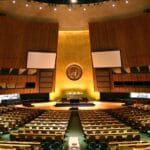The atomic age bears America’s original sin
By Yangyang Cheng | February 6, 2018

“Was it a compliment?” I asked the Italian architect Ludovico Centis after his presentation at the University of Chicago on December 2, 2017, which was 75 years to the day since a group of scientists led by Enrico Fermi achieved the world’s first controlled, self-sustained nuclear chain reaction on the same campus. To commemorate this scientific breakthrough and its complex legacy, the university organized a series of events, including a panel presentation on “Arts and the Nuclear Age,” with Centis as one of the speakers.
“Yes, of course,” he answered. And then, after a contemplating pause: “At that time, it was a compliment.”
The phrase I was referring to was “Christopher Columbus of the 20th century,” used by the Italian Embassy in the United States in the early 1960s to describe Fermi. One of the greatest scientific minds of the past century, Fermi left his native Italy for the United States amid rising anti-Semitism in 1938, the year he won the Nobel Prize in Physics.
As Centis showed in his presentation, in the decade following Fermi’s death in 1954, the Italian government corresponded with the University of Chicago about the possibility of a monument to honor their native son. The result was the iconic Henry Moore sculpture, “Nuclear Energy,” erected at the site of Fermi’s groundbreaking experiment on its 25th anniversary in 1967.
It was not the first time Fermi was compared to Columbus. On that fateful day 75 years ago when Fermi and his team lit the first atomic furnace, Arthur H. Compton, Manhattan Project scientist and chair of the physics department at the University of Chicago, relayed the news of the successful experiment to James B. Conant, the chairman of the National Defense Research Committee, with these coded words, “the Italian navigator has just landed in the New World.” The reference to another famous Italian centuries ago, meant only as a compliment, has an unintended parallel: Like Fermi, Columbus was a bold explorer whose discovery brought catastrophic consequences to a people. The badge of honor is also a bloody heirloom.
“The physicists have known sin, and this is a knowledge which they cannot lose.” The lead physicist of the Manhattan Project, J. Robert Oppenheimer, uttered these haunting words at a lecture two years after the atomic bombings of Hiroshima and Nagasaki. Despite similar cosmopolitan ideals shared between the pursuit of science and the idea of America, science is not immune to the historical ills or structural flaws of a country founded as a white supremacist patriarchy. To the contrary, the practice of science and the utilization of its discoveries have reflected and magnified America’s original sin. The dawn of the atomic age revealed both the promise and the limits of science and American exceptionalism, lessons from which are critically relevant yet poorly understood today.
The effects of racism. America is the country where humankind first split the atom and unleashed the power that fuels the stars. The saga of the first nuclear reaction, told a certain way, could have been an ode to American exceptionalism and human ingenuity, if not for its dark premise and tragic sequels.
The anti-Semitic laws in Europe drove many of its most brilliant minds across the Atlantic, to a country that counts as its founding myth being a nation of immigrants and “the mother of exiles,” despite its history of cruelty and discrimination toward anybody who did not meet its definition of personhood. Refugee scientists worked for America in a war against the home countries that denied their humanity, only to have their blind faith in America shattered when the bombs they built were dropped on hundreds of thousands of innocent civilians in a place far from the scientists’ homeland. The people of Hiroshima and Nagasaki became part of America’s experiment with its newly acquired power.
If Hitler had not been defeated in April 1945, would the United States have used nuclear weapons against Germany? This hypothetical question may never be answered, but it’s hard to deny the role racism played in the decision to use nuclear weapons against Japan. Non-white bodies have been continually dehumanized throughout American history, and it is easier to kill—or to contemplate the killing of—a foe seen as less than human. If racism did not drive the decision to use the Bomb in Japan, it certainly made the acceptance of it easier.
Originally it was not Hiroshima that topped the list of Japanese cities to target, but rather Kyoto, a major industrial and cultural center where many key factories were relocated during the war. Henry Stimson, Secretary of War under both Presidents Franklin D. Roosevelt and Harry Truman, repeatedly intervened to have Kyoto removed from the target list. Kyoto was the ancient capital of Japan, and Stimson had developed a personal fondness for its architectural and cultural heritage during his several visits there in the 1920s as governor of the Philippines.
Stimson was also the force behind the internment of some 117,000 Japanese Americans after the attack on Pearl Harbor. One of the darkest episodes of racial prejudice and paranoia in American history, the internment started in early 1942, the same year as the first controlled nuclear chain reaction. Stimson valued Japan’s temples and palaces more than the people who built them.
A lesser known fact about the bombing of Hiroshima is that, among the hundreds of thousands of casualties, about 10 percent were Korean. Japan occupied Korea during World War II, and forced many Koreans to work in Japan. The Hiroshima bombing also killed a small number of Allied prisoners of war, including about a dozen US soldiers. Would the United States have dropped the Bomb had there been tens of thousands of British or French in harm’s way? Even if the level of acceptable sacrifice is hard to gauge in the extraordinary circumstance of war, it is almost unimaginable that tens of thousands of victims—killed by what was essentially friendly fire—would be largely forgotten by the American public had they been white. Instead, the faces of dead Koreans blurred into a sea of dead Asians, because the divisions between “us” and “them” in the American psyche have always been constructed first and foremost along racial and ethnic lines.
The aftermath in Hiroshima and Nagasaki, horrific as it was, further desensitized the American military and policy establishment. Combined with the fact that such singular acts of mechanized slaughter brought the desired outcome of Japanese surrender when the continuous firebombing of Tokyo did not, the use of nuclear weapons raised the brutality threshold for what could be considered acceptable by decision makers in Washington. The American military would soon be raining fire across Asia from Korea to Vietnam. When the Nixon White House proposed and was eventually dissuaded from using nuclear weapons in the war with North Vietnam, the ensuing escalation of force could be viewed by the administration as acts of restraint or even of mercy. Non-white bodies, stamped from the beginning as savages, were met with acts of true savagery by Americans who self-identified as civilized people.
The role of gender. The horror of nuclear weapons won’t be lost on viewers of the “Nuclear Energy” sculpture in Chicago, marking the site where Pandora’s box was first opened by Fermi and his team. Standing several meters tall with three carved-out columns lifting a thick, round dome, the bronze creation is the splitting of an atom in abstraction, a mushroom cloud frozen in time, and a skull staring into the vastness with hollowed eyes. Its creator, the British sculptor Henry Moore, who experienced the horrors of chemical weapons firsthand as a soldier in World War I, injected an element of hopefulness; he described the bottom part of the sculpture as “the kind of interior of a cathedral.”
The duality of destruction and protection in the Moore sculpture is interpreted with a fascinating female gaze by the art historian Anne Wagner, who was also one of the speakers on the “Arts and the Nuclear Age” panel at the University of Chicago commemoration of the 75th anniversary of the first controlled nuclear chain reaction, and the 50th anniversary of the Moore sculpture. “The round shape, the fullness, and the glow of the dome remind me of a pregnancy,” said Wagner in her presentation. She compared the top part of the sculpture to Cindy Sherman’s 1986 photograph “Untitled #160”, a pregnant woman with a devilish grin, looking as if she is about to birth an alien monster, with the lighting of the image creating a bronze-like sheen.
In Svetlana Alexievich’s seminal work Voices from Chernobyl: The Oral History of a Nuclear Disaster, a midwife recounted her patients’ nightmares of giving birth to monsters, and young women expressed their fears of falling in love, “for some people it’s a sin to give birth. It’s a sin to love.” When a womb is penetrated by subatomic particles, invisible yet potentially deadly, the creation of a new life can also carry the seeds of its destruction. A woman’s ability to carry a child breaks through the boundaries of space and time, and bears witness to the omnipresence and lingering effects of a nuclear disaster.
“You must think it is a horrible leap from the dome to a womb,” Wagner said at her Chicago presentation, “but there was one woman at the first nuclear reaction, and she later became pregnant.” Of the 49 people on Fermi’s team, physicist Leona Woods was the only woman. She continued to work on the project through her pregnancy, covering her growing belly with baggy work clothes. Woods gave birth to a boy in 1944, and returned to work a few days later. In 1979, she published a memoir of her experience on the Manhattan Project, The Uranium People.
The invention of nuclear weapons was in itself a process of creation conflated with the ultimate destructive power. Upon the success of Fermi’s experiment, the nuclear physicist Ernest Lawrence telegraphed his colleagues in Chicago, “Congratulations to the new parents.” The Manhattan Project scientists chose phrases of male progeny, “it’s a boy”, to describe successful bomb tests, while “a girl” would mean the bomb was a dud. The misogynistic convention carried on in the names of “Little Boy” and “Fat Man.”
With only one woman, and everyone of European heritage, the scientific team at the creation of the Bomb shared the same gender and racial makeup as the American military and political leadership. The American Bomb was the white men’s bomb. As with many of the ugliest episodes in the history of America, the groups absent from the decision-making process bore the consequences of choices made by people who deemed themselves superior by birth.
Limits to American exceptionalism. Such superiority is often manifested through, and subsequently justified by, a paternalistic sense of self-righteous exceptionalism. When asked by Compton if he would ever place the welfare of the United States above the welfare of mankind, General Leslie Groves, who oversaw the Manhattan Project, gave this telling answer, “If you put it that way, there is only one answer. You must put the welfare of man first.”
“But show me if you can,” Groves continued, “an agency through which it is possible to do more for the service of man than can be done through the United States.”
“In my mind General Groves stands out as a classic example of the patriot,” Compton wrote in his memoir Atomic Quest. Holding a similar view of America’s role in the world, Compton argued that the United States had a duty to “do our utmost to effect the establishment of an adequate world police” and “keep nuclear weapons out of the hands of totalitarian regimes.”
Groves’ and Compton’s political philosophy still resonates in the upper echelons of the policy and military establishment in America today. As an immigrant from a one-party authoritarian state, I recognize the fundamental differences between the political systems of my birth country of China and my adopted home in America. No one should make false equivalencies, or doubt the superiority of a liberal democratic system, but love for America and belief in its ideals should not become blind faith in its infallibility or omnipotence.
The trust in American hegemony on nuclear power is bitterly ironic, considering that the United States remains the only country that has used nuclear weapons for war. Moreover, the existence of nuclear weapons has significantly weakened America’s democratic institutions, from the buildup of a massive security state to guard its nuclear secrets, to the expansion of executive power in bypassing Congress to take military action. America’s history of racism and discriminatory policies, remnants of which continue to this day, both narrows its thinking and weakens its credibility as it tries to uphold universal values and enforce them upon sovereign nations.
The brutal realities of the Cold War crushed America’s parochial fantasies of a monopoly on nuclear weapons, and more than once brought the world to the brink of nuclear Armageddon. I see similar flawed thinking at play today, as America struggles to find the proper response to North Korea’s advances in nuclear and missile technology. There are no good or easy ways out of the crisis, but what is particularly alarming is how war is being constantly raised as a plausible, or even preferred, option among America’s policy elites. When seen through racially tinted glasses, a whole region is dehumanized—with the dictator demonized, his people infantilized, and their neighbors objectified as collateral. When the president of the United States tweets about the bigger size and greater power of his nuclear button compared with Kim Jong-un’s, toxic masculinity turns nuclear war into a pissing contest.
Weapons of mass destruction pose serious threats in the hands of brutal regimes or non-state actors, but their ability to kill is not a derivative of, and cannot be masked by, the nature of their ownership. Emphasis on the superiority of one political system or the messianic role of one country, however exceptional, is the wrong premise to address global threats from nuclear weapons or any new technology.
Everyone has a stake. The founding of the United Nations, and the establishment of various international treaties and agreements after WWII, reflect the need for, and function of, global governance to achieve peace and stability. Women and indigenous people bear the disproportionate burdens of armed conflicts and nuclear testing, and their respective organizations have been on the forefront of advocacy to ban the Bomb. The International Campaign to Abolish Nuclear Weapons (ICAN), awarded the Nobel Peace Prize last year for pushing the United Nations to pass the landmark treaty to ban nuclear weapons, consists of diverse organizations including physician groups from Scandinavia, the Latin America Human Security Network, and the Women’s International League for Peace and Freedom.
At a time of rising threats from state and non-state actors, and the emergence of a new global technological Cold War, America’s role on the world stage should not be a retreat into isolationism, nor self-aggrandizing dominance. America’s continued leadership of the free world demands a reckoning with the sins of the nation’s past, and recognition of the limitations on its power. Effective American leadership requires the country to live up to its highest ideals at home and abroad, and to reaffirm its commitment to liberal democratic values and a rule-based international order in which everyone has a seat at the table.
Scientists have a unique role to play in the policy landscape. Just as the laws of physics apply the same regardless of color or creed, a scientist’s civic duty is not only to his or her home country, but also to humanity at large. To fulfill this obligation, the scientific community must become more inclusive both in its demographics and in its vision. Only when diverse stakeholders are all represented in the academy, can the implications of their research no longer be merely an academic exercise. Being on the forefront of advancing technology and human understanding of nature, scientists cannot retreat behind the notion of being neutral explorers, but must join the effort of moral pathfinding.
Together, we make the world safer.
The Bulletin elevates expert voices above the noise. But as an independent nonprofit organization, our operations depend on the support of readers like you. Help us continue to deliver quality journalism that holds leaders accountable. Your support of our work at any level is important. In return, we promise our coverage will be understandable, influential, vigilant, solution-oriented, and fair-minded. Together we can make a difference.
Topics: Nuclear Weapons, Voices of Tomorrow















